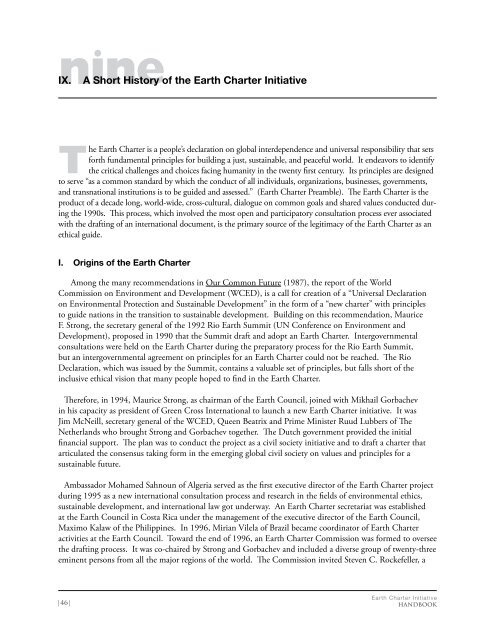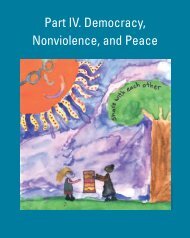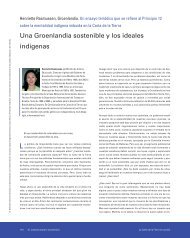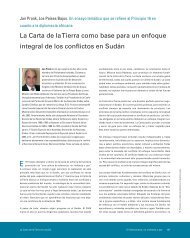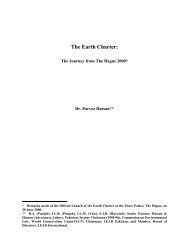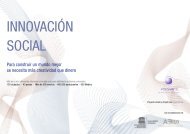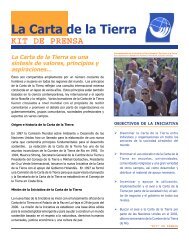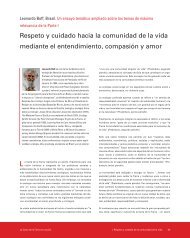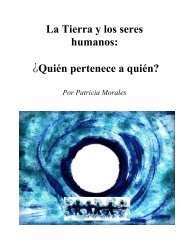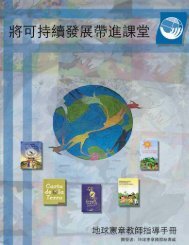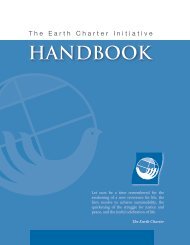Handbook English - Earth Charter Initiative
Handbook English - Earth Charter Initiative
Handbook English - Earth Charter Initiative
Create successful ePaper yourself
Turn your PDF publications into a flip-book with our unique Google optimized e-Paper software.
nine<br />
IX. A Short History of the <strong>Earth</strong> <strong>Charter</strong> <strong>Initiative</strong><br />
The <strong>Earth</strong> <strong>Charter</strong> is a people’s declaration on global interdependence and universal responsibility that sets<br />
forth fundamental principles for building a just, sustainable, and peaceful world. It endeavors to identify<br />
the critical challenges and choices facing humanity in the twenty first century. Its principles are designed<br />
to serve “as a common standard by which the conduct of all individuals, organizations, businesses, governments,<br />
and transnational institutions is to be guided and assessed.” (<strong>Earth</strong> <strong>Charter</strong> Preamble). The <strong>Earth</strong> <strong>Charter</strong> is the<br />
product of a decade long, world-wide, cross-cultural, dialogue on common goals and shared values conducted during<br />
the 1990s. This process, which involved the most open and participatory consultation process ever associated<br />
with the drafting of an international document, is the primary source of the legitimacy of the <strong>Earth</strong> <strong>Charter</strong> as an<br />
ethical guide.<br />
I. Origins of the <strong>Earth</strong> <strong>Charter</strong><br />
Among the many recommendations in Our Common Future (1987), the report of the World<br />
Commission on Environment and Development (WCED), is a call for creation of a “Universal Declaration<br />
on Environmental Protection and Sustainable Development” in the form of a “new charter” with principles<br />
to guide nations in the transition to sustainable development. Building on this recommendation, Maurice<br />
F. Strong, the secretary general of the 1992 Rio <strong>Earth</strong> Summit (UN Conference on Environment and<br />
Development), proposed in 1990 that the Summit draft and adopt an <strong>Earth</strong> <strong>Charter</strong>. Intergovernmental<br />
consultations were held on the <strong>Earth</strong> <strong>Charter</strong> during the preparatory process for the Rio <strong>Earth</strong> Summit,<br />
but an intergovernmental agreement on principles for an <strong>Earth</strong> <strong>Charter</strong> could not be reached. The Rio<br />
Declaration, which was issued by the Summit, contains a valuable set of principles, but falls short of the<br />
inclusive ethical vision that many people hoped to find in the <strong>Earth</strong> <strong>Charter</strong>.<br />
Therefore, in 1994, Maurice Strong, as chairman of the <strong>Earth</strong> Council, joined with Mikhail Gorbachev<br />
in his capacity as president of Green Cross International to launch a new <strong>Earth</strong> <strong>Charter</strong> initiative. It was<br />
Jim McNeill, secretary general of the WCED, Queen Beatrix and Prime Minister Ruud Lubbers of The<br />
Netherlands who brought Strong and Gorbachev together. The Dutch government provided the initial<br />
financial support. The plan was to conduct the project as a civil society initiative and to draft a charter that<br />
articulated the consensus taking form in the emerging global civil society on values and principles for a<br />
sustainable future.<br />
Ambassador Mohamed Sahnoun of Algeria served as the first executive director of the <strong>Earth</strong> <strong>Charter</strong> project<br />
during 1995 as a new international consultation process and research in the fields of environmental ethics,<br />
sustainable development, and international law got underway. An <strong>Earth</strong> <strong>Charter</strong> secretariat was established<br />
at the <strong>Earth</strong> Council in Costa Rica under the management of the executive director of the <strong>Earth</strong> Council,<br />
Maximo Kalaw of the Philippines. In 1996, Mirian Vilela of Brazil became coordinator of <strong>Earth</strong> <strong>Charter</strong><br />
activities at the <strong>Earth</strong> Council. Toward the end of 1996, an <strong>Earth</strong> <strong>Charter</strong> Commission was formed to oversee<br />
the drafting process. It was co-chaired by Strong and Gorbachev and included a diverse group of twenty-three<br />
eminent persons from all the major regions of the world. The Commission invited Steven C. Rockefeller, a<br />
|46|<br />
<strong>Earth</strong> <strong>Charter</strong> <strong>Initiative</strong><br />
HANDBOOK


